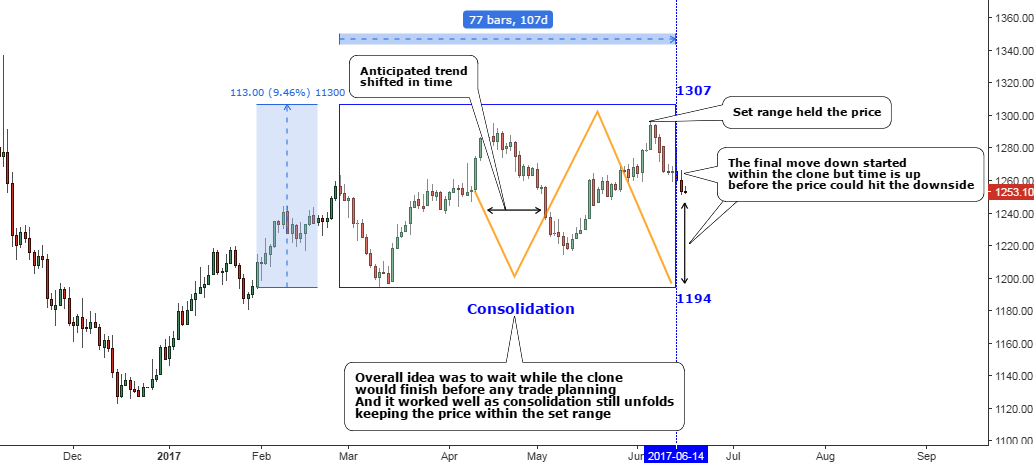Last week time ran out for the clone of the previous consolidation in the gold chart that I posted in April. I’ve updated the chart with a snapshot of the experiment’s result.
Snapshot Of The Experiment’s Results: Good, But Not Ideal

Chart courtesy of tradingview.com
All experiments are some sort of magic as we have an idea in our mind and try to apply it in the real world through an uncountable series of experiments to reach the desired result. But any result is a step forward to better understand what is going on in the real world. And the many side effects can bring us something genuinely new, especially when the experiment brings you an unexpected result.
The gold chart provided much better results than the silver chart that I posted earlier. The main difference is the period of the experiment – the silver clone took only eight days to finish while the gold clone continued for two months. That shows me that the gold clone is more valuable as it excludes more fortuities as more time has gone by.
Let’s move on to the clone rectangle itself. I would like to start from the cloned orange zigzag within the blue rectangle as the price should follow the path it set. The price didn’t drop as per the first orange line pointing to the downside and instead it moved sharply higher to the topside of the clone but didn’t touch it. Only after that move gold dropped sharply down to the opposite part of the rectangle. Then the orange zigzag reversed and pointed to the upside of the clone and so did the price, but with the shift in time as highlighted with the black double-head arrow. After it reached the upside of the rectangle the price again magically reversed down as it was planned by the orange zigzag. The drop was caught and remained unfinished in the middle of the way down as the time of the clone was up (blue vertical line). Let us see if we will reach $1194 soon.
The second parameter is the range set by the previous consolidation borders between the $1194 and $1307 marks. As we can see from the chart above the range parameters proved to be valid in spite of all the sharp moves within the rectangle and the margins were kept safe by holding volatility inside.
Last, but not the least is the importance of the time parameter. The price failed to repeat the orange zigzag and deliver the last move down. We all know that “ideal”, “absolute” and “perfect” are mostly the mirage words in our real life. And if one would track the price path instead of timing path he/she could reach the desired synchronization.
Overall, the idea was to wait while the clone finished its move before any trade planning and it worked well as consolidation still unfolds holding the price within the set range.
Intelligent trades!
Aibek Burabayev
INO.com Contributor, Metals
Disclosure: This contributor has no positions in any stocks mentioned in this article. This article is the opinion of the contributor themselves. The above is a matter of opinion provided for general information purposes only and is not intended as investment advice. This contributor is not receiving compensation (other than from INO.com) for their opinion.


How could *anything* really work when its been proven
metal markets are manipulated ...... your Zig will Zag ..
and your Zag will Zig .. ???? no ?
You should consider using Fibonacci on you time as well as price forecasts. A 100% clone may not be optimal, while a 61.8%, 127.2% or 161.8% may yield more consistent forecasts.
The 2017 chart looks to me like rising bottoms (Jan-$113/Mar-114/May-116/Jun-?117? turning up?) and rising tops (Jan-$116/Feb- ~118.5/then- ~120/Apr- ~122.5/Jun- ~123) from the late Dec 2016 lows of ~ $107. With a late June/July potential of ~$126/7+ if the up trend channel continues.
There are too many variables to predict the future. Just follow the long term trend.
Not heard of this before. Interesting. I would like to follow to see how it goes.